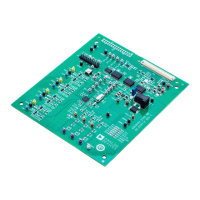ADE9000 Technical Reference Manual UG-1098
Rev. 0 | Page 43 of 86
INTERRUPTS/
EVENT
The ADE9000 has three pins,
IRQ0
,
IRQ1
, and CF4/
EVENT
/
DREADY, which can be used as interrupts to the host processor.
The
IRQ0
and
IRQ1
pins go low when an enabled interrupt
occurs and stay low until the event is acknowledged by setting
the corresponding status bit in the STATUS0 and STATUS1
registers, respectively. The
EVENT
function, which is
multiplexed with the CF4 and DREADY options on the
CF4/
EVENT
/DREADY pin, tracks the state of the enabled
signals and goes low and high with these internal signals. The
EVENT
function is useful for measuring the duration of events,
such as dips or swells, externally.
INTERRUPTS (
IRQ0
AND
IRQ1
)
The
IRQ0
and
IRQ1
pins are managed by 32-bit interrupt mask
registers, MASK0 and MASK1, respectively. Every event that
can generate an interrupt has a corresponding bit in the MASK0
or MASK1 register and the STATUS0 or STATUS1 register.
To enable an interrupt, set the corresponding bit in the
MASK0 or MASK1 register to 1. To disable an interrupt, the
corresponding bit in the MASK0 or MASK1 register must be
cleared to 0.
The STATUS0 and STATUS1 registers indicate if an event that
can generate an interrupt has occurred. If the corresponding bit
in the MASK0 or MASK1 register is set, an interrupt is generated
on the corresponding
IRQ0
or
IRQ1
pin, and the pin goes low.
To determine the source of the interrupt, read the
corresponding STATUS0 or STATUS1 register and identify
which enabled bits are set to 1. To acknowledge the event and
clear bits in the STATUSx register, write to the STATUSx
register with the desired bit positions set to 1. Then the
corresponding
IRQ0
or
IRQ1
pin goes high.
For example, if a zero-crossing occurs on the Phase A voltage
input and the ZXVA bit is set in the MASK1 register, the
IRQ1
pin goes low, indicating that an enabled event has occurred. To
acknowledge the event, write a 1 to the ZXVA bit in the
STATUS1 register, and then the
IRQ1
pin goes low. The ZXVA
STATUS1 bit is set regardless of whether the ZXVA bit is
enabled in MASK1.
There are a few interrupts that are nonmaskable, meaning that
they are generated even if the corresponding bit in the MASKx
register is 0. These nonmaskable interrupts include RSTDONE
and ERROR0.
There is an option to combine all the interrupts onto a single
interrupt pin,
IRQ1
, instead of using two pins,
IRQ0
and
IRQ1
.
To activate this option, set the IRQ0_ON_IRQ1 bit in the
CONFIG1 register. Note that the
IRQ0
pin still indicates the
enabled
IRQ0
events while in this mode, and
IRQ1
indicates
both
IRQ1
and
IRQ0
events.
The meaning of each individual interrupt source is provided in
the related data sheet section; refer to these sections in the
ADE9000 data sheet for more information.
EVENT
The
EVENT
function is multiplexed with CF4 and DREADY on
the CF4/
EVENT
/DREADY pin. To enable the
EVENT
function
to be output on this pin, write CF4_CFG = 10 in the CONFIG1
register.
There are 16 signals that can be incorporated into the
EVENT
pin and are selected in the EVENT_MASK register. All of these
events sources are maskable and disabled by default.
The logic level of the
EVENT
output is solely dependent on the
enabled events; it cannot be changed by the user. If any of the 16
events are enabled by setting their corresponding mask bit to 1
in the EVENT_MASK register, the
EVENT
pin goes low
whenever one of the enabled events occurs and stays low until
all the enabled signals have gone high. Then, the
EVENT
pin
goes high. Note that the status sources used to generate the
EVENT
are not latched; if one event source is selected, the
EVENT
pin tracks the status of that source.
STATUS BITS IN ADDITIONAL REGISTERS
Several interrupts are used in conjunction with other status
registers.
Overcurrent
The OI bit in the MASK1 register works in conjunction with the
OIPHASE status bits in the OISTATUS register.
No Load
The VAFNOLOAD, RFNOLOAD, AFNOLOAD, VANLOAD,
RNLOAD, and ANLOAD bits in the MASK1 register work in
conjunction with additional status bits in the PHNOLOAD register.
The following bits in the MASK0 register work with the status
bits in the PHSIGN register: REVAPx, REVRPx, and REVPSUMx.
Read the additional registers to obtain more information when
the corresponding bits are set in the STATUSx register.

